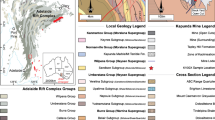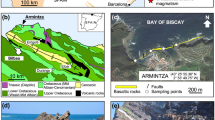Abstract
Pseudotachylytes occur associated with mylonite and ultramylonite in the Mahanadi shear zone (MSZ) in the Eastern Ghats Mobile Belt (EGMB). The MSZ is about 200 km long curvilinear high strain zone trending WNW-ESE in its eastern part that splays out in the west. In Kantilo-Ganian segment of MSZ in northern EGMB, an interbanded sequence of granulite facies lithoassemblage has undergone ductile shearing. Kinematic studies of mylonite and ultramylonite indicate MSZ to be a NE-dipping, extensional type ductile shear zone. Non-coaxial metamorphic growth of garnet and presence of truncated sillimanite-fish in ultramylonite suggest high temperature regime during shearing. Pseudotachylytes in MSZ occur as millimetre thick layers to decimetre thick zones containing fragments of mylonite, ultramylonite and lithic clasts. Pseudotachylyte generation veins are mostly sub-parallel to C-planes and the injection veins cross-cut at high angle to these. The presence of an isotropic glassy matrix, injection features, corroded grains and dendritic microlites can be evidences for the existence of a melt phase. The composition of pseudotachylyte matrix (by EPMA) indicates silica deficiency with higher normative hypersthene, plagioclase and lower quartz compared with average whole rock composition for host. Absence of overprinting of mylonitic fabric on pseudotachylytes indicates their formation by brittle failure without passing through a plastic deformation and thus a two stage development for mylonite-ultramylonite and pseudotachylyte generation is suggested.
Similar content being viewed by others
References
Allen, A.R. (1979) Mechanism of frictional fusion in fault zones. Jour. Struct. Geol., v.55, pp.239–256.
Allen, J.L. (2005) A multi-kilometre pseudotachylyte system as an exhumed record of earthquake rupture geometry at hypocentral depths (Colorado, USA) Tectonophysics, v.402, pp.37–54.
Bhattacharya, A., Mohanty, L., Maji, A., Sen, S.K. and Raith, M. (1992) Non-ideal mixing in the phlogopite-annite binary: constraints from experimental data on Mg-Fe partitioning and a reformulation of the biotite-garnet geothermometer. Contrib. Mineral. Petrol., v.111, pp.87–93.
Bossiere, G. (1991) Petrology of pseudotachylytes from the Alpine fault of New Zealand. Tectonophysics, v.196, pp.173–193.
Burlini, L. and Bruhn, D. (2005) High-strain zones: laboratory perspectives on strain softening during ductile deformation. Geol. Soc. London, v.245, pp.1–24.
Camacho, A., Vernon, R.H. and Fitzgerald, J.D. (1995) Large volumes of anhydrous pseudotachylyte in the Woodroffe Thrust, eastern Musgrave Ranges, Australia. Jour. Struct. Geol., v.17, pp.371–383.
Chattopadhyay, A., Khasdeo, L., Holdsworth, R.E. and Smith, S.A.F. (2008) Fault reactivation and pseudotachylite generation in the semi-brittle and brittle regimes: examples from the Gavilgarh-Tan Shear Zone, Central India. Geol. Mag., v.145(6), pp.766–777.
Chetty, T.R.K. (2001) The Eastern Ghats Mobile Belt, India: a collage of juxtaposed terranes (?). Gondwana Res., v.4, pp.319–328.
Chetty, T.R.K. (2007) Crustal architecture of the northern parts of the Eastern Ghats Mobile Belt, India: Correlation with Lambert rift. Intl. Assoc. for Gondwana Res., Conference Series No.4, pp.27–28.
Chetty, T.R.K. and Murthy, D.S.N. (1998) Regional tectonic framework of the Eastern Ghats Mobile Belt: a new interpretation. Geol. Surv. India Spec. Publ., No.44, pp.39–50.
Clough, C.T. (1888) The geology of the Cheviot Hills: England and Wales. In: Geol. Surv. Mem., Explanation of Sheet 108 NE, 22.
Dasgupta, S., Sengupta, P., Guha, D. and Fukuoka, M. (1991) A refined garnet-biotite Fe-Mg exchange geothermometer and its application in amphibolites and granulites. Contrib. Mineral. Petrol., v.109, pp.130–137.
Dobmeier, C.J. and Raith, M.M. (2003) Crustal architecture and evolution of the Eastern Ghats Belt and adjacent regions of India. Geol. Soc. London Spec. Publ. no.206, pp.145–168.
Grocott, J. (1981) Fracture geometry of pseudotachylite generation zones: a study of shear fractures formed during seismic events. Jour. Struct. Geol., v.3, pp.169–178.
Jeffreys, H. (1942) On the mechanics of faulting. Geol. Mag., v.79, pp.291–295.
Lapworth, C. (1885) The Highland controversy in British geology. Nature, v.32, pp.558–559.
Legros, F., Cantagrel, J.M. and Devouard, B. (2000) Pseudotachylyte (frictionite) at the base of the Arequipa volcanic landslide deposit (Peru): implications for emplacement mechanisms. Jour. Geol., v.108, pp.601–611.
Lisker, F. and Fachmann, S. (2001) The Phanerozoic history of the Mahanadi region, India. Jour. Geophy. Res., B: Solid Earth, v.106, pp.22027–22050.
Lund, M.G. and Austrheim, H. (2003) High-pressure metamorphism and deep-crustal seismicity: evidence from contemporaneous formation of pseudotachylytes and eclogite facies coronas. Tectonophysics, v.379, pp.59–83.
Maddock, R.H. (1983) Melt origin of pseudotachylites demonstrated by textures. Geology, v.11, pp.105–108.
Maddock, R.H. (1992) Effects of lithology, cataclasis and melting on the composition of fault-generated pseudotachylytes in Lewisian gneiss, Scotland. Tectonophysics, v.204, pp.261–278.
Maddock, R.H., Grocott, J. and Van Ness, M. (1987) Vesicles, amygdales, and other similar structures in fault-generated pseudotachylites. Lithos, v.20, pp.418–432.
Magloughlin, J.F. (1989) The nature and significance of pseudotachylite from the Nason terrane, North Cascade mountains, Washington. Jour. Struct. Geol., v.11, pp.907–917.
Magloughlin, J.F. (1992) Microstructural and chemical changesassociated with cataclasis and frictional melting at shallowcrustal levels: the cataclasite-pseudotachylyte connection. Tectonophysics, v.204, pp.243–260.
Magloughlin, J.F. and Spray, J.G. (1992) Frictional Melting Processes and Products in Geological Materials: Introduction and Discussion; Tectonophysics, v.204, pp.56–78.
Mahapatro, S.N., Nanda, J.K., Ghosh, S.P. and Tripathy, A.K. (2009) Patchy charnockitess from the Eastern Ghats Mobile Belt — examples from Titilagarh and Khandapara areas of Orissa. Vistas in Geological Research (Utkal Univ.), Spec. Publ. in Geol., v.8, pp.190–197.
Masch, L., Wenk, H.R. and Preuss, E. (1985) Electron microscopy study of hyalomylonites — evidence for frictional melting in landslides. Tectonophysics, pp.115, v.131–160.
Mishra, S.N. and Udhoji S.G., Unpublished GSI report, 1969–70.
Nanda, J.K. (2008) Tectonic framework of Eastern Ghats Mobile Belt: An overview. Mem. Geol. Soc. India, No.74, pp.63–87.
Nanda, J.K. and Pati, U.C. (1989) Filed relations and petrochemistry of the granulites and associated rocks in the Ganjam-Koraput sector of the Eastern Ghat belt. Indian Minerals, v.43(3&4), pp.247–264.
Nash, C.R., Rankin, L.R. Leeming, P.M. and Harris, L.B. (1996) Delineation of lithostructural domains in northern Orissa (India) from Landsat Thematic Mapper imagery. Tectonophysics, v.260, pp.245–257.
O’Hara, K. and Sharp, Z.D. (2001) Chemical and oxygen isotope composition of natural and artificial pseudotachylyte: role of water during frictional melting. Earth Planet. Sci. Lett., v.184, pp.393–406.
Passchier, C.W. (1982) Pseudotachylyte and the development of ultramylonite bands in the Saint-Barthélemy Massif, French Pyrenees. Jour. Struct. Geol., v.4, pp.69–79.
Passchier, C.W. and Trouw, R.A. (2005) Microtectonics. Second Edition, Springer, 366p.
Passchier, C.W., Hoek, J.D., Bekendam, R.F. and De Boorder, H. (1990) Ductile reactivation of Proterozoic brittle fault rocks; an example from the Vestfold Hills, East Antarctica. Precambrian Res., v.47, pp.3–16.
Pennacchionni, G., Di Toro, G. and Mancktelow, N.S. (2001) Strain-insensitive preferred orientation of porphyroclasts in Mont Mary mylonites. Jour. Struct. Geol., v.23(8), pp.1281–1298.
Ramakrishnan, M., Nanda, J.K. and Augustine, P.F. (1998) Geological evolution of the Proterozoic Eastern Ghats Mobile Belt. In: Proc. Workshop on Eastern Ghats Mobile Belt. Geol. Surv. India Spec. Publ. No.44, pp.1–21.
Ramsay, J.G. and Lisle, R.J. (2000), The Techniques of Modern Structural Geology, vol.3, Applications of Continuum Mechanics in Structural Geology, Academic Press, London, pp.702–717.
Rickers, K., Mezger, K. and Raith, M. (2001) Evolution of the continental crust in the Proterozoic Eastern Ghats Belt, India and new constraints for Rodinia reconstruction: implications from Sm-Nd, Rb-Sr and Pb-Pb isotopes. Precambrian Res., v.112, pp.183–210.
Roy, A. Sengupta, S. and Mandal, A. (2008) Synchronous development of mylonite and pseudotachylite in Ductile Shear Zone: An example from the Chitradurga Eastern Margin Shear Zone, Karnataka. Jour. Geol. Soc. India, v.72, pp.447–457.
Roy Chowdhury, S. and Choudhary, R.K. (1963–64) Unpubld. Geol. Surv. India Report, FS:1963-64.
Scholz, C.H. (1990) The Mechanics of Earthquakes and Faulting. Cambridge University Press. 439p.
Scott, J.S. and Drever, H.I. (1953) Frictional fusion along a Himalayan thrust. Proc. Royal Soc. Edinburgh, v.65, pp.121–142.
Sen, S.K. (1987) Origin of leptynites, an orthopyroxene-free granite gneiss in two granulite terranes of India. Recent researches in Geology. In: A. K. Saha (Ed.), Geological Evolution of Peninsular India, Petrological and Structural aspects. Hindusthan Pub., v.13, pp.117–124.
Seth, B.K. (1962–63) Unpubld. Geol. Surv. India Report, FS:1962-63
Shand, S.J. (1916) The pseudotachylite of Parijs (Orange Free State). Geol. Soc. London Quart. Jour., v.72, pp.198–221.
Sibson, R.H. (1975) Generation of pseudotachylite by ancient seismic faulting. Geophys. Jour. Royal Astron. Soc., v.43, pp.775–794.
Sibson, R.H. (1980) Power dissipation and stress levels on faults in the upper crust. Jour. Geophys. Res., v.85, pp.6239–6249.
Spray, J.G. (1992) A physical basis for the frictional melting of some rock-forming minerals. Tectonophysics, v.204, pp.205–221.
Spray, J.G. (1993) Viscosity determinations of some frictionally generated silicate melts: implication for fault zone rheology at high strain rates. Jour. Geophys. Res., v.98, pp.8053–8068.
Spray, J.G. (1995) Pseudotachylyte controversy: fact or friction? Geology, v.23, pp.1119–1122.
Thompson, L.M. and Spray, J.G. (1994) Pseudotachylytic rock distribution in the Sudbury impact structure. Spec. Publ. Geol. Soc. Amer., v.293, pp.75–287.
Spray, J.G. and Thompson, L.M. (1995) Friction melt distribution in a multi-ring impact basin. Nature, v.373, pp.130–132.
Swanson, M.T. (1992) Fault structure, wear mechanisms and rupture processes in pseudotachylyte generation. Tectonophysics, v.204, pp.223–242.
Takagi, H., Goto, K. and Shigematsu, N. (2000) Ultramylonite bands derived from cataclasite and pseudotachylite in granites, northeast Japan. Jour. Struct. Geol., v.22, pp.1325–1339.
Toyoshima, T. (1990) Pseudotachylite from the main zone of the Hidaka metamorphic belt, Hokkaido, northern Japan, Jour. Meta. Geol., v.8, pp.507–523.
Wenk, H.R. (1978) Are pseudotachylites products of fracture or fusion? Geology, v.6, pp.507–511.
Wenk, H.R., Johnson, L.R. and Rarschbacher, L. (2000) Pseudotachylites in the Eastern Peninsular Ranges of California. Tectonophysics, v.321, pp.253–277.
Author information
Authors and Affiliations
Corresponding author
Rights and permissions
About this article
Cite this article
Mahapatro, S.N., Tripathy, A.K., Nanda, J.K. et al. Coexisting ultramylonite and pseudotachylyte from the eastern segment of the Mahanadi shear zone, Eastern Ghats Mobile Belt. J Geol Soc India 74, 679–689 (2009). https://doi.org/10.1007/s12594-009-0184-8
Received:
Accepted:
Published:
Issue Date:
DOI: https://doi.org/10.1007/s12594-009-0184-8




